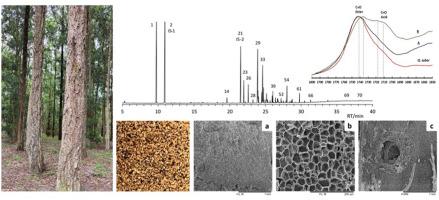Discovering the corky bark of Eucalyptus suberea from anatomical and chemical perspectives – a case study
IF 2
4区 生物学
Q4 BIOCHEMISTRY & MOLECULAR BIOLOGY
引用次数: 0
Abstract
This paper presents the first scientific investigation of the corky bark of Eucalyptus suberea (cork mallee). The study involved two trees with diameters of 23 cm (A) and 47 cm (B), collected from a plantation in Portugal. Anatomical analysis, performed by scanning electron microscopy, revealed the presence of cork cells'. The chemical characterization included summative chemical analysis, FTIR, GC-MS/FID for suberin composition and Py-GC-MS for lignin composition. E. suberea extractive-free barks A and B contained 29 % and 25 % suberin, 30 % and 37 % lignin, and 39 % and 38 % polysaccharides, respectively. The bark A exhibited a higher extractives content (49 %) than just 14 % for bark B. Dichloromethane extract from bark A was notably rich in alkanol ferulates. The main components of E. suberea A and B suberins were glycerol, with 15 % and 11 %, ω-hydroxyacids, with 45 % and 50 %, and α,ω-diacids, with 30 % and 17 %, representing a total of ca. 90 % and 78 % of E. suberea A and B suberins mass, respectively. Both suberins showed low contents of epoxides and vic-diols; also, both presented the particularity of having high contents of free acid groups, especially the suberin of bark B, suggesting a polyester structure with a smaller than usual degree of polymerization. E. suberea corky bark presents a lignin composition that differentiates from the cork G-lignins analyzed until now with a monomer composition exhibiting a GS character, with more G- (53–56 %) than S-units (34–37 %) with an S/G ratio between 0.64 and 0.66, for A and B lignins, respectively.

从解剖学和化学角度发现桉树软木树皮-一个案例研究
本文首次对桉树软木树皮进行了科学研究。这项研究涉及两棵直径分别为23厘米(A)和47厘米(B)的树,它们来自葡萄牙的一个种植园。通过扫描电子显微镜进行的解剖分析显示了软木塞细胞的存在。化学表征包括总结化学分析、FTIR、GC-MS/FID和Py-GC-MS。无提取物树皮A和B分别含有29%和25%的木质素,30%和37%的木质素,39%和38%的多糖。A树皮的提取物含量(49%)高于b树皮的提取物含量(14%)。A树皮的二氯甲烷提取物含有丰富的烷醇阿魏酸酯。其主要成分为甘油(15%和11%)、ω-羟基酸(45%和50%)和α - ω-二酸(30%和17%),分别占A和B的90%和78%左右。两种衍生物的环氧化物和维二醇含量均较低;此外,两者都具有较高的游离酸基团含量的特殊性,特别是树皮B的木质素,表明其聚酯结构的聚合度低于通常的聚合度。E. suberea软木树皮的木质素组成与迄今为止分析的软木G-木质素不同,其单体组成具有GS特征,a和B木质素的G-(53 - 56%)比S-(34 - 37%)多,S/G比分别在0.64和0.66之间。
本文章由计算机程序翻译,如有差异,请以英文原文为准。
求助全文
约1分钟内获得全文
求助全文
来源期刊

Biochemical Systematics and Ecology
生物-进化生物学
CiteScore
3.00
自引率
12.50%
发文量
147
审稿时长
43 days
期刊介绍:
Biochemical Systematics and Ecology is devoted to the publication of original papers and reviews, both submitted and invited, in two subject areas: I) the application of biochemistry to problems relating to systematic biology of organisms (biochemical systematics); II) the role of biochemistry in interactions between organisms or between an organism and its environment (biochemical ecology).
In the Biochemical Systematics subject area, comparative studies of the distribution of (secondary) metabolites within a wider taxon (e.g. genus or family) are welcome. Comparative studies, encompassing multiple accessions of each of the taxa within their distribution are particularly encouraged. Welcome are also studies combining classical chemosystematic studies (such as comparative HPLC-MS or GC-MS investigations) with (macro-) molecular phylogenetic studies. Studies that involve the comparative use of compounds to help differentiate among species such as adulterants or substitutes that illustrate the applied use of chemosystematics are welcome. In contrast, studies solely employing macromolecular phylogenetic techniques (gene sequences, RAPD studies etc.) will be considered out of scope. Discouraged are manuscripts that report known or new compounds from a single source taxon without addressing a systematic hypothesis. Also considered out of scope are studies using outdated and hard to reproduce macromolecular techniques such as RAPDs in combination with standard chemosystematic techniques such as GC-FID and GC-MS.
 求助内容:
求助内容: 应助结果提醒方式:
应助结果提醒方式:


